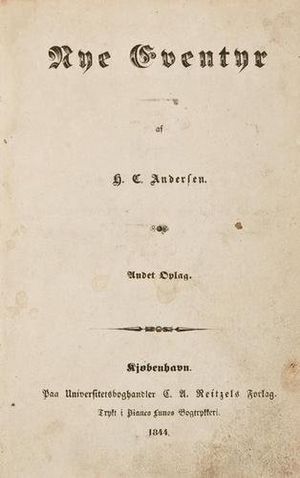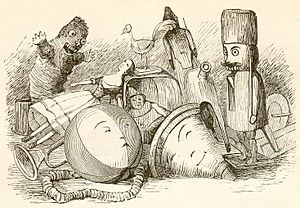New Fairy Tales. First Volume facts for kids

Cover of the first edition of Nye Eventyr.
|
|
| Author | Hans Christian Andersen |
|---|---|
| Original title | Nye Eventyr. Første Bind |
| Country | Denmark |
| Language | Danish |
| Genre | Literary fairy tale collection |
| Publisher | C. A. Reitzel |
|
Publication date
|
11 November 1843 – 7 April 1845 |
| Media type | |
New Fairy Tales. First Volume (which in Danish is Nye Eventyr. Første Bind) is a book with nine fairy tales by the famous writer Hans Christian Andersen. These stories came out in three parts. They were published by C. A. Reitzel in Copenhagen, Denmark between November 1843 and April 1845.
Contents
What's Inside
First Collection: Stories from 1843
The first part of New Fairy Tales. First Volume was called Nye Eventyr. Første Bind. Første Samling. It was released on November 11, 1843. This collection included four stories:
- "The Angel" ("Engelen") is about a dead child and an angel. They gather flowers for Heaven. The angel finds a lily in a trash pile. He explains that this flower had made a dying child happy. The angel then reveals he was that child. This story was very popular at the time.
- "The Nightingale" ("Nattergalen") tells of the Emperor of China. He loves the songs of a real nightingale and a mechanical bird. When the mechanical bird breaks, the Emperor gets very sick. The real nightingale's song makes him well again. Andersen wrote this story in just one day. It shows that natural beauty is better than artificial things.
- "The Sweethearts; or, The Top and the Ball" ("Kjærestefolkene [Toppen og bolden]") is about a wooden top that loves a leather ball. Years later, the top finds the ball old and dirty. He pretends not to know her. This story might be based on Andersen's own life.
- "The Ugly Duckling" ("Den grimme ælling") is about a clumsy bird. Other animals make fun of him. He feels lonely and sad. But then, he grows up to be a beautiful swan. This story is one of Andersen's most famous. He once said it was like his own life story. It teaches that it doesn't matter where you start if you have a special spirit inside.
All these stories were invented by Andersen. Many of them show parts of his own life and feelings. Andersen himself is like the heroes in these tales. He is the awkward duckling, the nightingale, and the shiny top.
Second Collection: Stories from 1844
The second part of New Fairy Tales. First Volume was called Nye Eventyr. Første Bind. Anden Samling. It came out on December 21, 1844. This collection had two stories:
- "The Fir-Tree" ("Grantræet")
- "The Snow Queen" ("Snedronningen")
Third Collection: Stories from 1845
The third and last part of New Fairy Tales. First Volume was called Nye Eventyr. Første Bind. Tredie Samling. It was published on April 7, 1845. This collection included five stories:
- "The Elf Mound" ("Elverhøi")
- "The Red Shoes" ("De røde Skoe")
- "The Jumpers" ("Springfyrene")
- "The Shepherdess and the Chimney Sweep" ("Hyrdinden og Skorstensfejeren")
- "Holger Danske"
Main Ideas in the Stories
The first group of stories often talks about change. This change can be about growing up, finding faith, or discovering your artistic talent. These tales are very hopeful. They show how pain can turn into joy through suffering and understanding.


